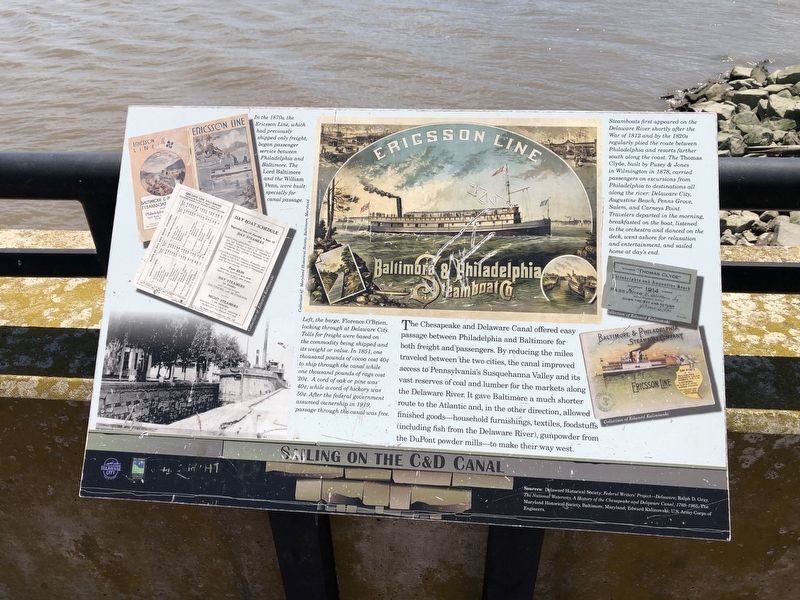Delaware City in New Castle County, Delaware — The American Northeast (Mid-Atlantic)
Sailing on the C&D Canal
The Chesapeake and Delaware Canal offered easy passage between Philadelphia and Baltimore for both freight and passengers. By reducing the miles traveled between the two cities, the canal improved access to Pennsylvania's Susquehanna Valley and its vast reserves of coal and lumber for the markets along the Delaware River. It gave Baltimore a much shorter route to the Atlantic and, in the other direction, allowed finished goods—households furnishings, textiles, foodstuffs (including fish from the Delaware River), gunpowder from the DuPont powder mills—to make their way west.
[Captions:]
In the 1870s, the Ericsson Line, which had previously shipped only freight, began passenger service between Philadelphia and Baltimore. The Lord Baltimore and the William Penn, were built specially for canal passage.
Left, the barge, Florence O'Brien, locking through at Delaware City. Tolls for freight were based on the commodity being shipped and its weight or value. In 1851, one thousand pounds of cocoa cost 40¢ to ship through the canal while one thousand pounds of rags cost 20¢. A cord of oak or pine was 40¢, while a cord of hickory was 50¢. After the federal government assumed ownership in 1919, passage through the canal was free.
Steamboats first appeared on the Delaware River shortly
after the War of 1812 and by the 1820s regularly plied the route between Philadelphia and resorts farther south along the coast. The Thomas Clyde, built by Pusey & Jones in Wilmington in 1878, carried passengers on excursions from Philadelphia to destinations all along the river: Delaware River, Augustine Beach, Penns Grove, Salem, and Carneys Point. Travelers departed in the morning, breakfasted on the boat, listened to the orchestra and danced on the deck, went ashore for relaxation and entertainment, and sailed home at day's end.Erected by City of Delaware City, Delaware; Delaware Land & Water Conservation Trust Fund.
Topics and series. This historical marker is listed in these topic lists: Industry & Commerce • Parks & Recreational Areas • Waterways & Vessels. In addition, it is included in the Chesapeake & Delaware (C&D) Canal series list. A significant historical year for this entry is 1851.
Location. 39° 34.741′ N, 75° 35.203′ W. Marker is in Delaware City, Delaware, in New Castle County. Marker is at the intersection of Clinton Street and Harbor Street, on the right when traveling north on Clinton Street. Touch for map. Marker is at or near this postal address: 55 Clinton St, Delaware City DE 19706, United States of America. Touch for directions.
Other nearby markers. At least 8 other markers are within walking distance of this marker. Small But Mighty (within shouting distance of this marker); The Lock at Delaware City
Credits. This page was last revised on June 2, 2021. It was originally submitted on June 2, 2021, by Devry Becker Jones of Washington, District of Columbia. This page has been viewed 121 times since then and 23 times this year. Photos: 1, 2. submitted on June 2, 2021, by Devry Becker Jones of Washington, District of Columbia.

